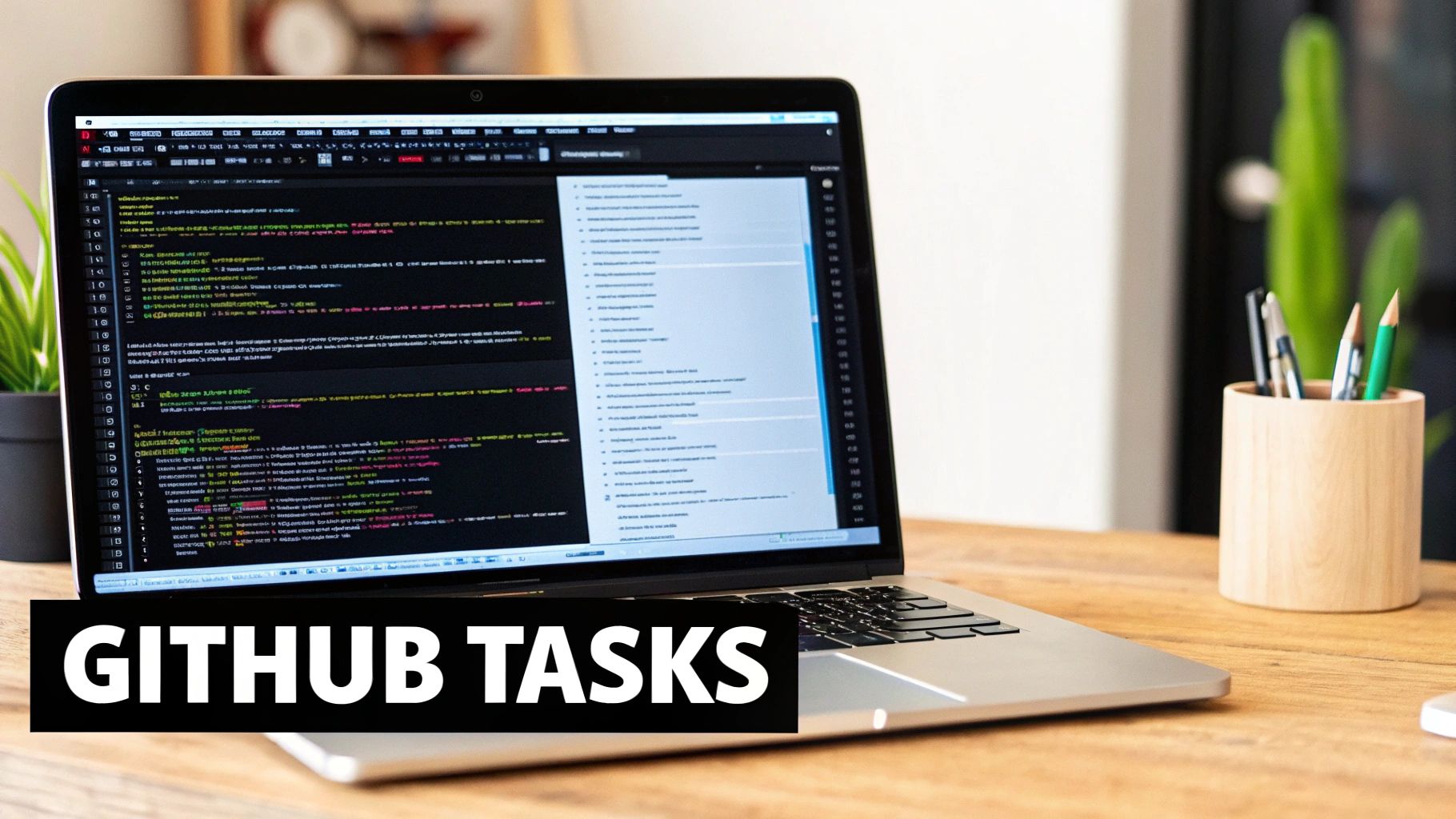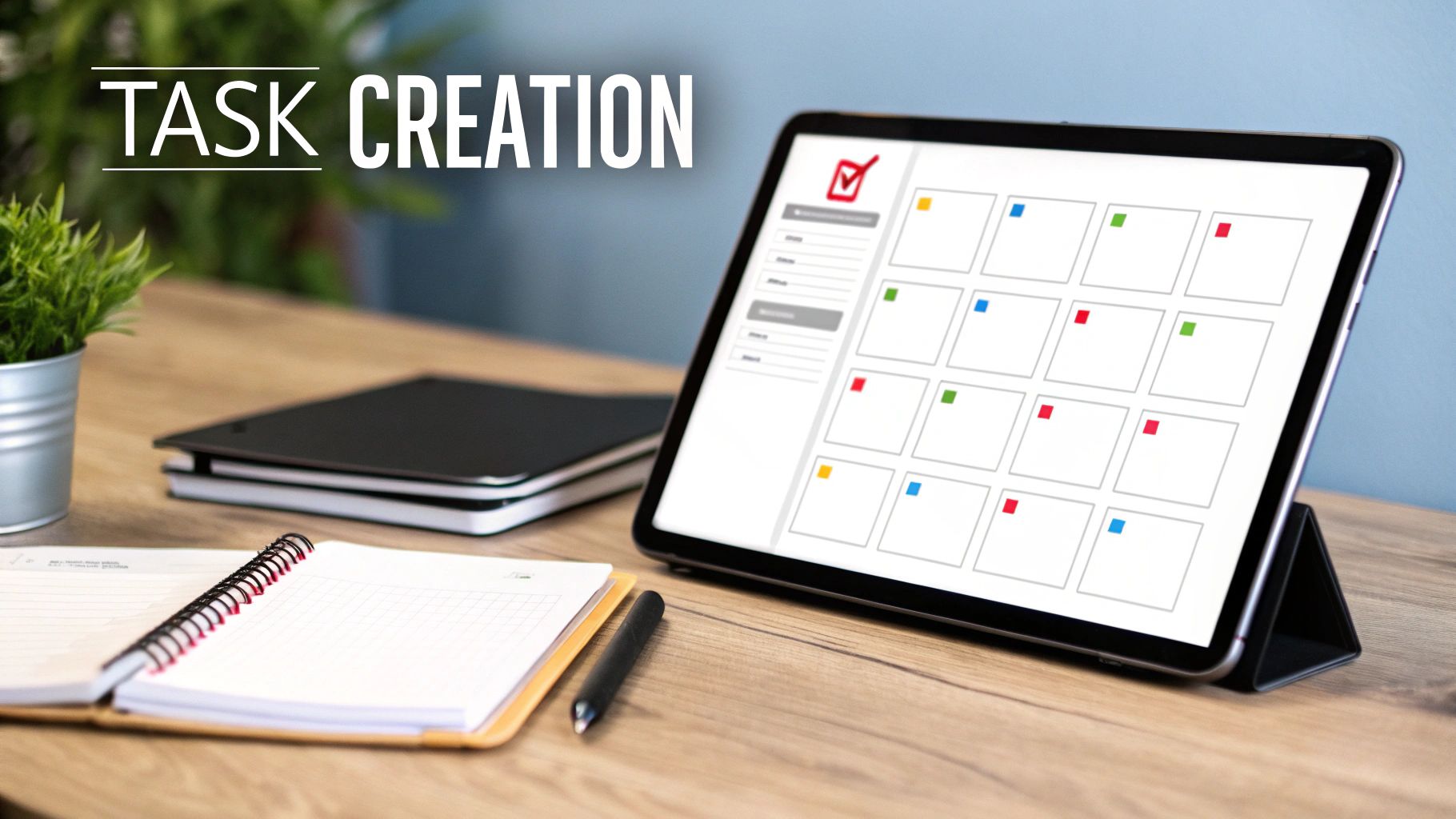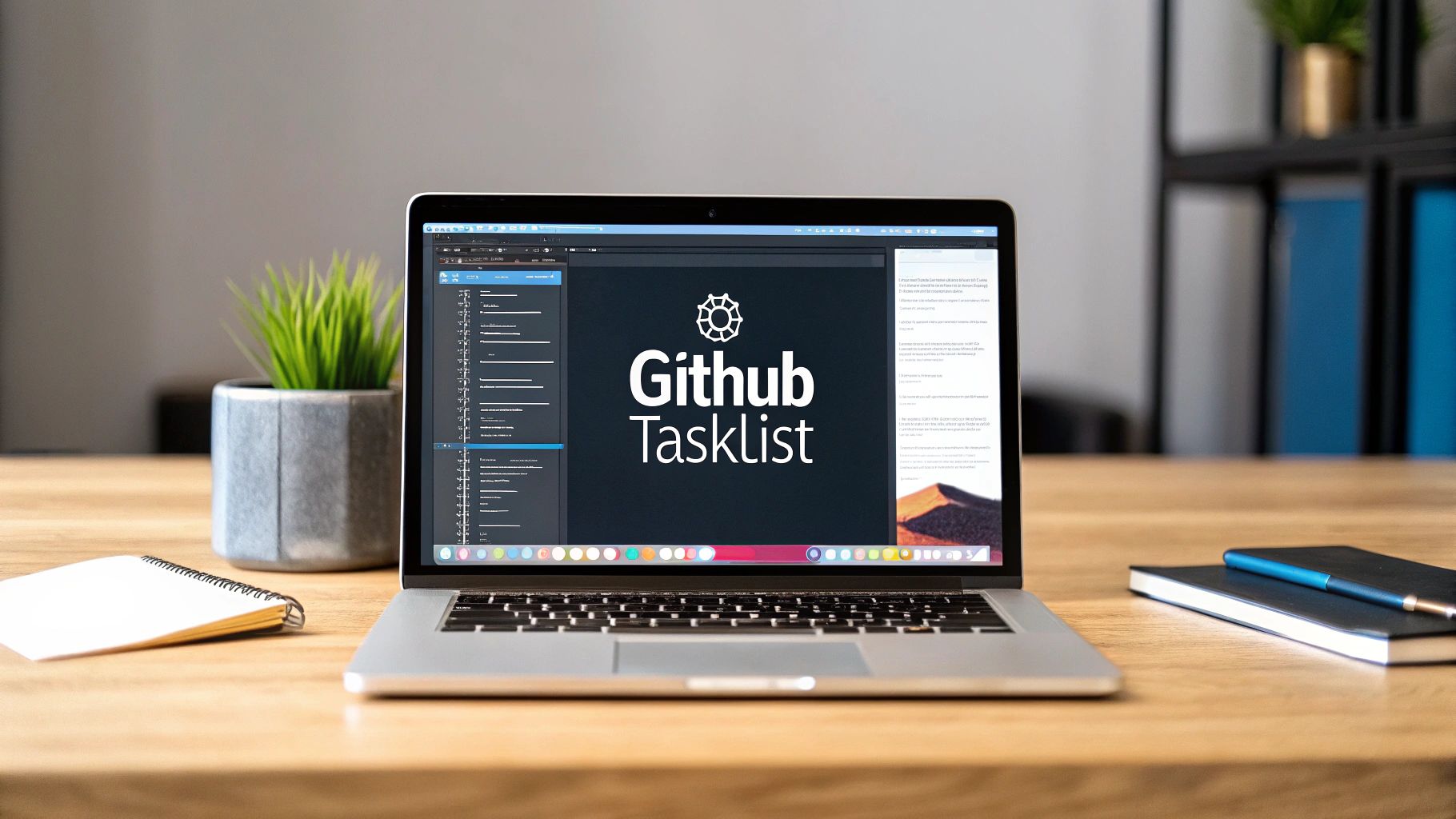Boost Productivity with GitHub Tasklist
Understanding GitHub Tasklist Fundamentals

Organizing project work can be challenging, but GitHub tasklists offer a helpful tool for managing complex projects. These Markdown-based checklists are a core component of developer workflows, simplifying projects and boosting team collaboration. Let's explore the fundamentals of GitHub tasklists and see how they work in practice.
One of the primary benefits of a GitHub tasklist is its ability to break down large problems into smaller, manageable parts. It's similar to assembling a complex LEGO set: instead of tackling the entire structure at once, you follow step-by-step instructions. Tasklists provide a similar roadmap for coding projects, ensuring that no critical step is missed.
Tasklists also provide clear visual feedback on project progress. As tasks are completed and checked off, the team gains a sense of accomplishment and everyone stays informed about the current status.
GitHub tasklists are integrated directly within issues and pull requests. This keeps all project information centralized, eliminating the need to use separate platforms or spreadsheets for task management. Centralizing information makes communication easier and ensures everyone is working from the same information. Furthermore, tasklists included in the initial comment of an issue or pull request are readily visible in list views, offering a convenient progress overview. Since their introduction, GitHub task lists have become essential tools for developers, helping them to break down complex issues into smaller, more manageable tasks. Created using Markdown, these lists enable easy progress tracking and conversion of tasks into individual issues.
Visual Indicators and Team Reliance
The visual nature of GitHub tasklists is invaluable. An unchecked box indicates an open task, a checked box represents completion, and a partially filled box signifies work in progress. This clear visual representation eliminates confusion and provides a quick status update for every task. For example, during code reviews, a tasklist can be used to follow up on feedback implementation, verifying that all necessary changes have been applied. This streamlined approach reduces back-and-forth communication, improving the efficiency of the code review process. For more detailed information on effective use, see this article on how to master GitHub task lists.
Many development teams have incorporated GitHub tasklists into their standard workflow. They offer substantial benefits, including better team coordination, increased transparency, and improved productivity. By breaking down complex projects and visually representing progress, tasklists allow teams to work more effectively. This saves time and contributes to a more organized development workflow. Ultimately, incorporating GitHub tasklists leads to a smoother and more collaborative development experience. Learn more about GitHub Tasklists here.
Creating Your First GitHub Tasklist That Works

Now that we understand the value of GitHub tasklists, let's explore how to create one. A well-structured tasklist begins with a solid grasp of Markdown syntax. Think of Markdown as the language of your tasklist. Using precise syntax ensures your instructions are clear and effective.
Mastering the Markdown Syntax
The core element of any GitHub tasklist is the bracket-space combination: - [ ]. This generates an empty checkbox, symbolizing an incomplete task. To mark a task as finished, simply replace the space with an "x": - [x]. This simple change visually represents your progress and keeps your project neatly organized.
For example, a basic GitHub tasklist for a new project might look like this:
- [ ] Create a new repository
- [ ] Add a README file
- [ ] Set up project structure
- [ ] Write initial code
This concise list makes tracking your progress straightforward.
Structuring Complex Projects With Nested Subtasks and Referencing Issues
Most projects, however, demand more than a basic list. This is where nested subtasks become invaluable. They provide another level of organization by dividing larger tasks into smaller, actionable steps. To create a nested subtask, simply indent it with four spaces. This clearly displays the task hierarchy and dependencies.
You can also connect your tasks directly to related issues within your project. By using the # symbol followed by the issue number, you create a direct link, keeping everything centralized and readily accessible.
Common Pitfalls and Best Practices
A frequent mistake in creating GitHub tasklists is inconsistent indentation. This disrupts the nested structure, making the list hard to follow. Maintaining consistent spacing is crucial for a clear visual hierarchy.
To help illustrate effective Markdown usage, let's look at a table summarizing various syntax examples. This table will provide a quick reference guide for creating and managing your tasklists.
GitHub Tasklist Markdown Syntax Examples
Common Markdown patterns for creating effective GitHub tasklists in different scenarios
| Syntax | Display Result | Use Case |
|---------------------|---------------------------|-------------------------------------------------|
| - [ ] Task | ☐ Task | Uncompleted Task |
| - [x] Task | ☑ Task | Completed Task |
| - [ ] Subtask | ☐ Subtask | Nested Subtask under a parent task |
| - [ ] #123 | ☐ #123 | Referencing an existing issue (#123) |
| - [ ] Link Text | ☐ Link Text | Create a hyperlink to an external resource |
This table provides a clear overview of how different Markdown syntax elements are rendered within a GitHub tasklist. Understanding these elements allows you to create more dynamic and informative tasklists.
By grasping these fundamental principles and mastering Markdown, you can create effective GitHub tasklists that optimize your workflow and boost project success. A well-structured GitHub tasklist is more than a simple checklist; it’s a powerful tool for managing complexity, tracking progress, and ultimately, achieving your project goals.
GitHub Tasklist for Personal Productivity Mastery

Beyond collaborative coding, a GitHub tasklist offers a powerful framework for personal productivity. Many developers are finding that the tools they use for managing complex software projects can also be effective for their daily lives. This approach consolidates personal and professional tasks within a single, familiar platform.
Organizing Daily Work and Implementing GTD Workflows
One popular method is using GitHub for a Getting Things Done (GTD) workflow. Each task, from grocery shopping to writing a blog post, becomes an issue. This lets you track progress, set deadlines, and prioritize, just as you would with software projects. You could create a dedicated repository for personal tasks or integrate them into existing project repositories.
This system allows for a granular level of control over your daily activities. By breaking down larger goals into smaller, actionable tasks, you can make steady progress and maintain a clear sense of direction. This approach also facilitates better time management by providing a visual overview of all your commitments.
Leveraging Public Repositories for Accountability and Visual Progress Tracking
Consider making your personal task repository public for increased accountability. While not for everyone, public repositories can provide external motivation. Even private repositories offer significant organizational and progress-tracking benefits. The concept of using GitHub for personal tasks is gaining traction, with some individuals creating 'life repositories'. Discover more insights about this here. They use familiar features like issue tracking and Markdown formatting for personal tasks.
By treating life events as issues and utilizing project boards, they maintain a structured approach to their lives. This methodical approach helps to ensure that nothing is overlooked and that all tasks receive the appropriate attention. The visual nature of GitHub's interface further enhances this process.
Categorizing Tasks, Creating Recurring Reminders, and Maintaining Motivation
Managing personal and professional tasks in GitHub requires clear categorization. Using labels and milestones, you can differentiate between work and personal issues, maintaining clear boundaries within a unified system. This minimizes context switching and keeps everything organized.
You can also use GitHub issues for recurring tasks. Setting reminders and due dates ensures that important tasks, both personal and professional, don't slip through the cracks. This is particularly helpful for recurring bills or appointments.
The visual progress tracking in GitHub tasklists is a powerful motivator. Seeing checked-off tasks provides a sense of accomplishment, maintaining momentum and encouraging engagement with your goals. You might be interested in: How to master developer productivity. Integrating your workflows into GitHub creates a powerful system for achieving goals, big and small. This allows for deep focus and organization, ensuring both personal and professional responsibilities are managed effectively within a single trusted environment.
Advanced GitHub Tasklist Techniques That Save Time

Let's explore how to truly maximize the power of the GitHub tasklist. These advanced techniques will transform your checklists from simple to-dos into dynamic project management tools, leading to more efficient workflows and better team communication.
Automating Workflows With GitHub Actions
Imagine automatically triggering a deployment every time a specific task is checked off in a pull request. With GitHub Actions, this is entirely possible. Configure your actions to respond to tasklist updates, turning a manual process into an automated one. This saves valuable time and reduces the potential for human error. This same automation can be extended to other workflows, such as sending notifications or updating project boards.
Linking Tasks and Mastering Keyboard Shortcuts
For projects that span multiple repositories, linking tasks across them is crucial. Referencing issues across repositories keeps everything in context and provides a unified view of project progress. This cross-repository linking also strengthens collaboration by connecting related tasks and facilitating communication between teams.
For improved local workflows, consider using tools like Git-task, which allows you to manage tasks locally within your Git repository and synchronize them with GitHub.
Mastering keyboard shortcuts is another essential aspect of efficient tasklist management. Quickly navigating and updating tasks within GitHub reduces overhead and accelerates your workflow. This allows you to spend less time managing tasks and more time coding.
Integrating With GitHub Projects
Integrating GitHub tasklists with GitHub Projects provides a visual representation of your project's status, improving progress tracking and dependency management. By visualizing task connections, you gain a more complete understanding of your project, making it easier to identify potential bottlenecks and keep things on track.
Maintaining Consistency in Code Reviews
Maintaining tasklist consistency is particularly important for large projects with multiple contributors. Establishing clear conventions for task creation and updates helps ensure everyone is on the same page. This reduces ambiguity and improves overall project quality.
Using tasklists effectively during code reviews is another valuable technique. Tracking feedback implementation directly within the pull request’s tasklist creates a transparent record of all changes. This establishes a clear audit trail and ensures all feedback is addressed, making code reviews more efficient and helping to resolve issues promptly. These advanced tasklist techniques transform simple checklists into powerful tools for project success.
GitHub Tasklist for Seamless Team Collaboration
Teams flourish when communication is clear and work is well-organized. A GitHub tasklist empowers development teams to fine-tune their coordination, make projects more transparent, and ultimately, deliver high-quality code more quickly. This section explores how successful teams use GitHub tasklists to transform their collaboration.
Practical Approaches for Assigning Tasks and Establishing Team Conventions
Assigning tasks within a GitHub tasklist clarifies who is responsible for what. By mentioning team members directly (e.g., @username) in task descriptions, you not only assign ownership but also trigger automatic notifications, keeping everyone in the loop. This eliminates ambiguity and ensures clear responsibility. For example, a task like "- [ ] @JohnDoe Implement user authentication" clearly assigns the task to John. For further information, check out this guide on How to master adding checklists to pull requests.
Establishing clear team conventions for using tasklists is equally important. This includes defining how tasks are created, labeled, and updated. Consistent practices reduce confusion and ensure everyone understands the workflow. For example, agreeing on a standard format for task descriptions promotes clarity and organization. Consistent use of labels helps categorize tasks and enables efficient filtering and reporting.
Creating Tasklist Templates, Tracking Dependencies, and Maintaining Real-Time Status Visibility
Creating tasklist templates for recurring tasks or standard procedures saves valuable time. This standardizes work across projects and eliminates the need to recreate tasklists repeatedly. For instance, a template for setting up a new project might include tasks such as creating a README, setting up the project structure, and configuring testing environments.
Tracking dependencies between team members is simplified with GitHub tasklists. By linking tasks or using references (e.g., #issue_number), teams gain a clear understanding of how individual contributions fit into the bigger picture. This helps anticipate potential roadblocks and effectively coordinate schedules.
Maintaining real-time status visibility through tasklists reduces the need for frequent status update meetings. As team members check off completed tasks, the entire team can see the project’s progress, keeping everyone informed without excessive communication. This enhanced transparency keeps everyone aligned and motivated. GitHub's widespread adoption, with over 100 million users as of 2023, highlights the popularity of project management features like task lists. Learn more about this topic.
Addressing Common Challenges and Creating a More Cohesive Development Environment
One common challenge in tasklist management is ensuring task ownership. Clearly defined assignments and regular communication are essential to addressing this. Another challenge is keeping status information up-to-date. Encouraging team members to promptly update their tasks and integrating tasklists into existing workflows helps maintain accurate status reflection.
GitHub tasklist implementation strategies vary depending on team size. Smaller teams might find simple checklists sufficient, while larger teams may benefit from more structured approaches. The following table provides a comparison of these strategies:
To help illustrate effective strategies, let's look at a comparison of approaches for different team sizes.
GitHub Tasklist Implementation Across Team Sizes: Comparison of GitHub tasklist adoption strategies based on team size and structure
| Team Size | Recommended Approach | Common Challenges | Success Metrics | |---|---|---|---| | Small (1-5) | Basic checklists within issues/pull requests | Maintaining consistency | Task completion rate, Reduced meeting time | | Medium (6-15) | Tasklist templates, integration with project boards | Tracking dependencies, ensuring task ownership | Project velocity, Improved communication | | Large (16+) | Automation with GitHub Actions, integration with external project management tools | Maintaining real-time status visibility, scaling conventions across teams | On-time delivery, Reduced project overhead |
As you can see, the complexity of the approach scales with the team size. Smaller teams can achieve success with simpler methods, while larger teams require more sophisticated strategies.
By addressing these common challenges and implementing appropriate strategies, teams can utilize GitHub tasklists to foster a more cohesive and efficient development environment. This leads to improved team communication, increased productivity, and a higher quality end product.
Connecting GitHub Tasklist With Your Favorite Tools
Connecting your GitHub tasklist with the other tools your team uses can significantly improve workflow and communication. This integration allows developers to stay within their preferred GitHub environment while keeping other team members, who might use different tools, informed and involved. Let's examine how to bridge the gap between GitHub and popular platforms like Jira, Trello, and Asana.
API-Based Integrations For Two-Way Data Flow
One powerful approach is using API-based integrations. These integrations establish a two-way data flow between GitHub and your tool of choice. For example, when a task is marked complete in your GitHub tasklist, the corresponding task in Jira automatically updates to reflect the change. Conversely, changes made in Jira can be reflected back in GitHub.
This creates a seamless connection, ensuring data consistency across platforms and reducing the need for manual updates. This real-time synchronization keeps everyone on the same page, regardless of their preferred platform.
Enhancing Functionality With Browser Extensions and CLI Tools
Browser extensions offer another convenient way to enhance GitHub tasklist functionality. Several extensions designed specifically for GitHub provide features like enhanced task management, time tracking, and reporting, all within your browser.
This added layer of convenience allows you to manage tasks without ever leaving the GitHub interface. This is especially helpful for those who prefer a centralized workflow.
For developers comfortable working in the terminal, CLI tools offer similar advantages. These command-line tools provide robust task management capabilities directly within the terminal environment.
This allows you to create, update, and manage your GitHub tasklists without opening a web browser, streamlining your workflow. This is a significant benefit for developers who spend most of their time in the command line.
Streamlining Communication With Notification Systems
Integrating notification systems with your GitHub tasklist can also greatly improve communication. Services like Slack or email notifications can be triggered by tasklist updates, automatically alerting team members of changes.
For example, when a task is completed, a notification can be sent to the relevant team members in Slack. This automated communication keeps everyone informed, reducing email clutter and promoting quick responses to project updates.
Generating Insights From Tasklist Data
Several services offer analytics tools designed for GitHub. These tools can extract data from your tasklists to generate insightful reports on project progress, team performance, and potential bottlenecks.
This data-driven approach provides valuable insights that can be used to optimize workflows and improve team efficiency. Identifying bottlenecks early can lead to significant time savings and improved project delivery.
By connecting your GitHub tasklist with these tools, you create a cohesive productivity ecosystem. Information flows freely between platforms, eliminating manual effort and ensuring everyone stays synchronized. This empowers teams to collaborate more effectively and achieve their goals with greater efficiency.
Ready to take your GitHub tasklist to the next level? Pull Checklist, a GitHub Marketplace app, automates and streamlines your code review process with powerful, condition-based checklists. Learn more about Pull Checklist and enhance your workflow today.
